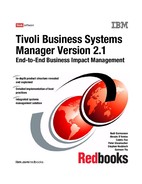Book Description
This IBM Redbooks publication gives a broad understanding of the IBM Tivoli Business Systems Manager architecture and internals. The in-depth discussion covers the product’s inner workings and includes log files to illustrate the processing of its various components.
IBM Tivoli Business Systems Manager is designed to display all aspects of the enterprise’s IT system as they affect the users’ business systems. This book enables easy implementation of IBM Tivoli Business Systems Manager in distributed environments. Procedures are illustrated with examples of the installation and configuration process to explain the deployment of IBM Tivoli Business Systems Manager into a customer’s environment.
This book also covers the implementation of IBM Tivoli Business Systems Manager in z/OS with most of its major interfaces. IBM Tivoli Business Systems Manager can monitor all major IBM subsystems in z/OS, including IMS, DB2, CICS, storage, and Web solutions.
A book about concepts and implementation would not be complete without a comprehensive discussion about using, maintaining, and troubleshooting the system. We devote several sections to these topics.
Please note that the additional material referenced in the text is not available from IBM.
Table of Contents
- Figures
- Tables
- Notices
- Preface
- Part 1: Concept and planning
- Chapter 1: Introduction to business systems management
- Chapter 2: Components and functions
- Chapter 3: Database structure
- Chapter 4: User interface
- Chapter 5: Implementation planning
- Part 2: Distributed implementation
- Chapter 6: Base services implementation
- Chapter 7: TEC components integration
- Chapter 8: IBM Tivoli Monitoring integration
- Chapter 9: IBM Tivoli NetView integration
- Part 3: z/OS integration
- Chapter 10: z/OS installation and configuration
- Chapter 11: z/OS data feeds and discovery
- z/OS data feeds overview
- System Automation for OS/390 Version 2.1
- Database 2 (DB2) for z/OS
- Information Management System (IMS)
- CICSPlex System Manager Version 2.2
- Tivoli Workload Scheduler for z/OS
- Resource Object Data Manager
- Resource Measurement Facility (RMF)
- System Managed Storage (SMS)
- DFSMS Hierarchical Storage Manager
- WebSphere HTTP Server for OS/390
- Part 4: Advanced configuration
- Chapter 12: Automatic Business System View creation
- Chapter 13: Setting up roles and security
- Chapter 14: Maintenance and tuning issues
- Chapter 15: Automatic problem ticketing
- Chapter 16: High availability and failover
- Chapter 17: Historical reporting with TEDW
- Part 5: Appendixes
- Abbreviations and acronyms
- Related publications
- Index
- Back cover
